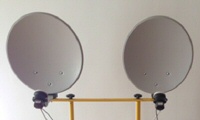Accept
Details & settings
This website uses cookies for cookie consent and statistics.
Evgeny Ulanov, Noah Schneiders

Last year, students from our school tried to build a radio interferometer consisting of two satellite dishes in order to achieve a high radio imaging resolution. However, they were not able to detect interference between the signals from both dishes as the oscillators in both LNBs (low-noise block downconverters) were not synchronised.
We have replaced these oscillators with a single one. Initially, we tested our approach using a small model of an interferometer to be able to identify and rectify any problems. This has allowed us to conduct successful solar measurements. Then we have applied our successful approach to a larger, fully functional radio interferometer consisting of two 1.25m mirrors and a baseline of 10m. We used this larger interferometer for a number of measurements of astronomical sources including the sun, the moon and Orion A.
Where the signals were too weak to lead to a clearly recognizable interference pattern, we recorded the phase difference of the incoming signals and used Fourier analysis to identify the presence and location of the source.
As our interferometer is designed to have a long lifetime, it will be made available to interested amateurs and physics courses after the contest.